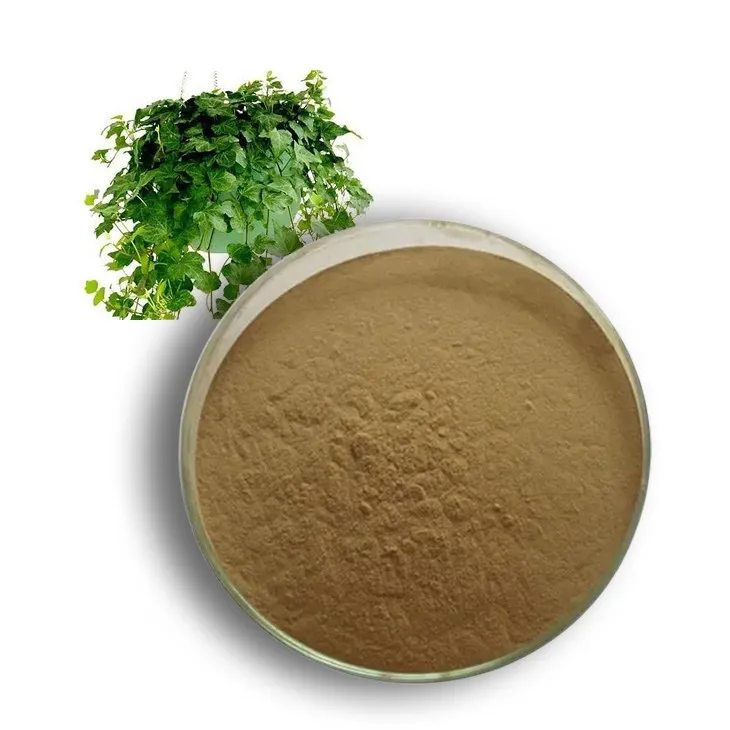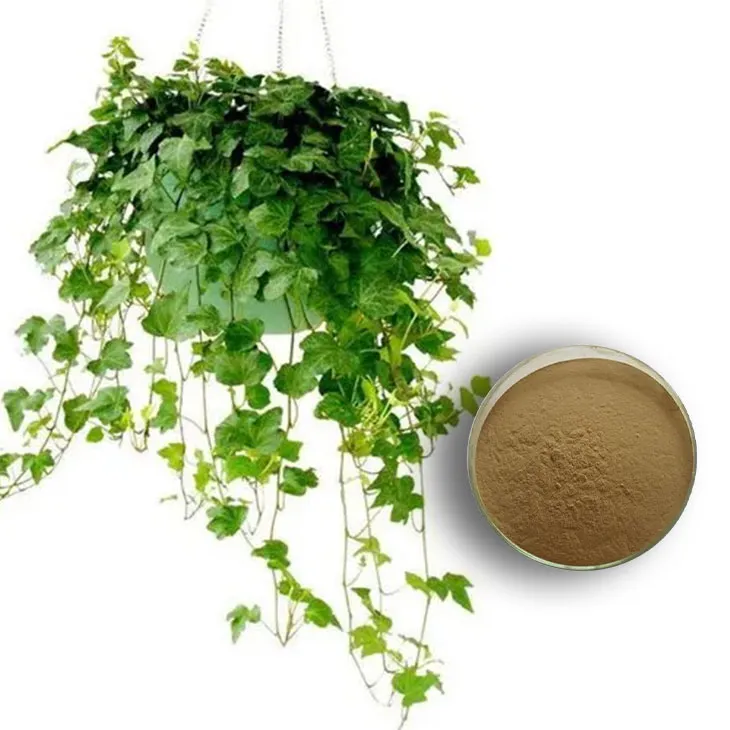- 0086-571-85302990
- sales@greenskybio.com
How to make powder from ivy extract?
2024-11-28

1. Introduction
Ivy is a plant that has been used in traditional medicine for various purposes. Extracting and converting it into powder form can enhance its usability, preservation, and potential applications. This article will explore the detailed process of making powder from Ivy Extract, covering extraction methods, purification steps, and drying techniques.

2. Ivy Extraction Methods
2.1 Solvent Extraction
Solvent selection: The choice of solvent is crucial in the extraction process. Ethanol and water are commonly used solvents for Ivy Extraction. Ethanol is effective in extracting a wide range of active compounds from ivy. It has good solubility for many phytochemicals such as flavonoids and saponins. Water, on the other hand, is a more environmentally friendly and cost - effective option. However, it may extract different compounds compared to ethanol.
Extraction procedure:
- First, collect fresh ivy leaves. Wash them thoroughly to remove any dirt or impurities.
- Chop the leaves into small pieces. This increases the surface area for better extraction.
- For ethanol extraction, soak the chopped leaves in ethanol in a sealed container. The ratio of leaves to ethanol can be around 1:5 (weight/volume). Stir the mixture occasionally and let it stand for a period of time, usually 24 - 72 hours at room temperature.
- For water extraction, follow a similar procedure but use water instead of ethanol. Boiling water can also be used for a shorter extraction time, but this may lead to the degradation of some heat - sensitive compounds.
- After the extraction period, filter the mixture using a filter paper or a Buchner funnel to separate the liquid extract from the solid plant material.
2.2 Supercritical Fluid Extraction
Principle: Supercritical fluid extraction (SFE) uses a supercritical fluid, usually carbon dioxide (CO₂), as the extracting agent. CO₂ in its supercritical state has properties between those of a gas and a liquid. It has high diffusivity and low viscosity, which allows it to penetrate the plant material easily and extract the desired compounds efficiently.
Procedure:
- Place the dried and ground ivy material into the extraction vessel of the SFE apparatus.
- The CO₂ is pressurized and heated to reach its supercritical state. The pressure and temperature conditions are typically around 7.38 MPa and 31.1 °C respectively.
- The supercritical CO₂ is passed through the ivy material for a specific period of time, usually several hours.
- As the supercritical CO₂ extracts the compounds from the ivy, it is then passed through a separator where the pressure is reduced. This causes the CO₂ to return to its gaseous state, leaving behind the extracted compounds in a concentrated form.

3. Purification Steps
3.1 Filtration and Sedimentation
After the initial extraction, the extract may still contain some solid particles, such as cell debris or undissolved plant material. Filtration can be used to remove these larger particles. A simple filter paper can be used for a rough filtration, followed by a more fine - grained filter, such as a membrane filter, for better purification.
Sedimentation can also be employed. Let the extract stand still in a container for a period of time. The heavier particles will gradually settle to the bottom, and the supernatant can be carefully decanted for further purification.
3.2 Chromatographic Purification
Column Chromatography:
- Prepare a chromatography column filled with an appropriate stationary phase, such as silica gel or alumina.
- Load the ivy extract onto the top of the column.
- Use a suitable mobile phase, such as a mixture of solvents, to elute the compounds through the column. Different compounds will have different affinities for the stationary and mobile phases, and thus will be separated as they move through the column.
- Collect the eluted fractions containing the desired compounds based on their characteristics, such as color or the presence of specific chemical reactions.
High - Performance Liquid Chromatography (HPLC):
- Inject the ivy extract into the HPLC system. The HPLC uses a high - pressure pump to force the mobile phase through a column filled with a very fine - grained stationary phase.
- The separation is highly efficient and can separate compounds with very similar properties. The detector in the HPLC system can identify and quantify the separated compounds based on their absorbance or fluorescence properties.
- Collect the pure fractions of the desired compounds for further processing.

4. Drying Techniques
4.1 Spray Drying
Principle: Spray drying is a popular method for converting liquid extracts into powder. The liquid extract is sprayed into a hot drying chamber through a nozzle. The hot air in the chamber quickly evaporates the solvent, leaving behind dry powder particles.
Procedure:
- Prepare the ivy extract in a suitable concentration. It should have a relatively low viscosity to ensure proper spraying.
- Set up the spray drying equipment. Adjust the inlet and outlet temperatures of the drying chamber. The inlet temperature is usually in the range of 150 - 200 °C, and the outlet temperature is around 80 - 100 °C.
- Spray the extract into the drying chamber through the nozzle. The droplet size of the spray can affect the quality of the final powder. Smaller droplets generally result in finer powder with better homogeneity.
- Collect the dried powder from the collection vessel at the bottom of the drying chamber.
4.2 Freeze - Drying
Principle: Freeze - drying, also known as lyophilization, involves freezing the ivy extract first and then reducing the pressure to allow the frozen water (or solvent) to sublimate directly from the solid to the gas phase without passing through the liquid phase. This helps to preserve the structure and activity of the compounds in the extract.
Procedure:
- Freeze the purified ivy extract in a suitable container. The freezing temperature can be - 20 °C or lower depending on the nature of the extract.
- Place the frozen extract into the freeze - drying chamber. Reduce the pressure in the chamber to a very low level, typically around 0.1 - 0.3 mbar.
- The sublimation process can take several hours to days depending on the amount of water (or solvent) in the extract. Monitor the process to ensure complete drying.
- Once the freeze - drying process is complete, remove the dried powder from the chamber.
5. Quality Control
5.1 Chemical Analysis
Identification of Compounds: Use techniques such as spectroscopy (e.g., infrared spectroscopy, UV - Vis spectroscopy) and mass spectrometry to identify the compounds present in the ivy extract powder. This helps to ensure that the desired active compounds are present and that no harmful or unwanted substances have been introduced during the extraction and processing steps.
Quantification of Active Compounds: HPLC can be used to accurately quantify the amount of active compounds in the powder. This is important for standardizing the product and ensuring its consistency in terms of potency.
5.2 Microbiological Testing
Test for the presence of microorganisms such as bacteria, fungi, and yeasts. The ivy extract powder should meet certain microbiological standards to ensure its safety for use. Plate count methods can be used to determine the number of viable microorganisms in the powder.
6. Conclusion
Making powder from ivy extract involves a series of complex but manageable steps. From the extraction methods, through purification, to the drying techniques, each step plays a crucial role in obtaining high - quality ivy extract powder. Quality control measures are also essential to ensure the safety and efficacy of the final product. With proper attention to these processes, it is possible to produce ivy extract powder that can be used in various applications, such as in the pharmaceutical, cosmetic, or food industries.
FAQ:
What are the common extraction methods for ivy extract?
Common extraction methods for ivy extract include solvent extraction. Solvents such as ethanol or water can be used. Maceration is a simple method where the ivy material is soaked in the solvent for a period to allow the active components to dissolve. Another method is percolation, which involves the slow passage of the solvent through the ivy material to extract the desired substances.
Why is purification necessary in making ivy extract powder?
Purification is necessary in making ivy extract powder because the initial extract may contain impurities such as other plant materials, pigments, and unwanted chemical compounds. These impurities can affect the quality, safety, and efficacy of the final powder product. Purification helps to remove these unwanted substances, leaving behind a more concentrated and pure form of the active ingredients in the ivy extract.
What are the suitable drying techniques for ivy extract?
Spray drying is a commonly used technique for drying ivy extract. In spray drying, the liquid extract is sprayed into a hot air stream, which quickly evaporates the moisture, leaving behind fine powder particles. Freeze - drying is also suitable. It involves freezing the extract first and then removing the water by sublimation in a vacuum environment. This method can better preserve the bioactivity of the extract compared to some other drying methods.
How can we ensure the quality of ivy extract powder?
To ensure the quality of ivy extract powder, strict control should be applied during the entire production process. Firstly, the quality of the raw ivy material should be carefully selected and inspected. During extraction, the parameters such as solvent type, extraction time, and temperature should be optimized. The purification process should be effective in removing impurities. And in the drying step, appropriate drying techniques and parameters should be used to avoid over - drying or under - drying that may affect the powder's quality. Additionally, quality testing such as analyzing the active ingredient content and testing for contaminants should be carried out regularly.
Are there any safety precautions when making ivy extract powder?
Yes, there are safety precautions when making ivy extract powder. Ivy may contain some substances that can be irritating or toxic if not properly handled. When handling the raw ivy material, appropriate protective equipment such as gloves should be worn. During extraction and purification, the use of chemicals should be in accordance with safety regulations. Also, in the drying process, proper ventilation is required to avoid the accumulation of any potentially harmful vapors or dust.
Related literature
- Ivy Extract: Properties and Applications"
- "Advanced Techniques in Plant Extract Powder Production"
- "The Science of Purifying Botanical Extracts"
- ▶ Hesperidin
- ▶ citrus bioflavonoids
- ▶ plant extract
- ▶ lycopene
- ▶ Diosmin
- ▶ Grape seed extract
- ▶ Sea buckthorn Juice Powder
- ▶ Beetroot powder
- ▶ Hops Extract
- ▶ Artichoke Extract
- ▶ Reishi mushroom extract
- ▶ Astaxanthin
- ▶ Green Tea Extract
- ▶ Curcumin Extract
- ▶ Horse Chestnut Extract
- ▶ Other Problems
- ▶ Boswellia Serrata Extract
- ▶ Resveratrol Extract
- ▶ Marigold Extract
- ▶ Grape Leaf Extract
- ▶ blog3
- ▶ blog4
-
Extraction process of stevia extract.
2024-11-28
-
Chinese Grape Seed Extract Powder Factory.
2024-11-28
-
Vitamin K2 in China vs. the United States.
2024-11-28
-
Nature's Bounty L - Arginine
2024-11-28
-
Quercetin
2024-11-28
-
Moringa powder
2024-11-28
-
Red Vine Extract
2024-11-28
-
Konjac Powder
2024-11-28
-
Black Pepper Extract
2024-11-28
-
Buckthorn bark extract
2024-11-28
-
Curcuma Longa Extract/Turmeric extract
2024-11-28
-
Polygonum multiflorum extract
2024-11-28
-
Selenium yeast
2024-11-28
-
Licorice Root Extract Powder
2024-11-28





















